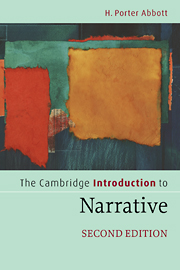Book contents
- Frontmatter
- Contents
- List of illustrations
- Preface
- Preface to the second edition
- Acknowledgments
- Chapter 1 Narrative and life
- Chapter 2 Defining narrative
- Chapter 3 The borders of narrative
- Chapter 4 The rhetoric of narrative
- Chapter 5 Closure
- Chapter 6 Narration
- Chapter 7 Interpreting narrative
- Chapter 8 Three ways to interpret narrative
- Chapter 9 Adaptation across media
- Chapter 10 Character and self in narrative
- Chapter 11 Narrative and truth
- Chapter 12 Narrative worlds
- Chapter 13 Narrative contestation
- Chapter 14 Narrative negotiation
- Notes
- Bibliography
- Glossary and topical index
- Index of authors and narratives
Chapter 2 - Defining narrative
- Frontmatter
- Contents
- List of illustrations
- Preface
- Preface to the second edition
- Acknowledgments
- Chapter 1 Narrative and life
- Chapter 2 Defining narrative
- Chapter 3 The borders of narrative
- Chapter 4 The rhetoric of narrative
- Chapter 5 Closure
- Chapter 6 Narration
- Chapter 7 Interpreting narrative
- Chapter 8 Three ways to interpret narrative
- Chapter 9 Adaptation across media
- Chapter 10 Character and self in narrative
- Chapter 11 Narrative and truth
- Chapter 12 Narrative worlds
- Chapter 13 Narrative contestation
- Chapter 14 Narrative negotiation
- Notes
- Bibliography
- Glossary and topical index
- Index of authors and narratives
Summary
The bare minimum
Simply put, narrative is the representation of an event or a series of events. “Event” is the key word here, though some people prefer the word “action.” Without an event or an action, you may have a “description,” an “exposition,” an “argument,” a “lyric,” some combination of these or something else altogether, but you won't have a narrative. “My dog has fleas” is a description of my dog, but it is not a narrative because nothing happens. “My dog was bitten by a flea” is a narrative. It tells of an event. The event is a very small one – the bite of a flea – but that is enough to make it a narrative.
Few, if any, scholars would dispute the necessity of at least one event for there to be narrative, but there are a number who require more than this. Some require at least two events, one after the other (Barthes, Rimmon-Kenan). And more than a few go even further, requiring that the events be causally related (Bal, Bordwell, Richardson). To both of these camps, my examples of narrative above would appear too impoverished to qualify. In my own view and that of still others (Genette, Smith), the field of narrative is so rich that it would be a mistake to become invested in a more restrictive definition that requires either more than one event or the sense of causal connection between events.
- Type
- Chapter
- Information
- The Cambridge Introduction to Narrative , pp. 13 - 27Publisher: Cambridge University PressPrint publication year: 2008
- 1
- Cited by



